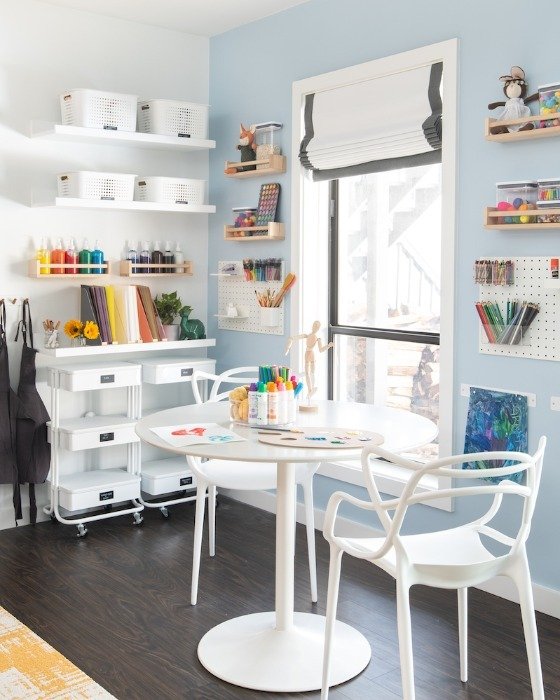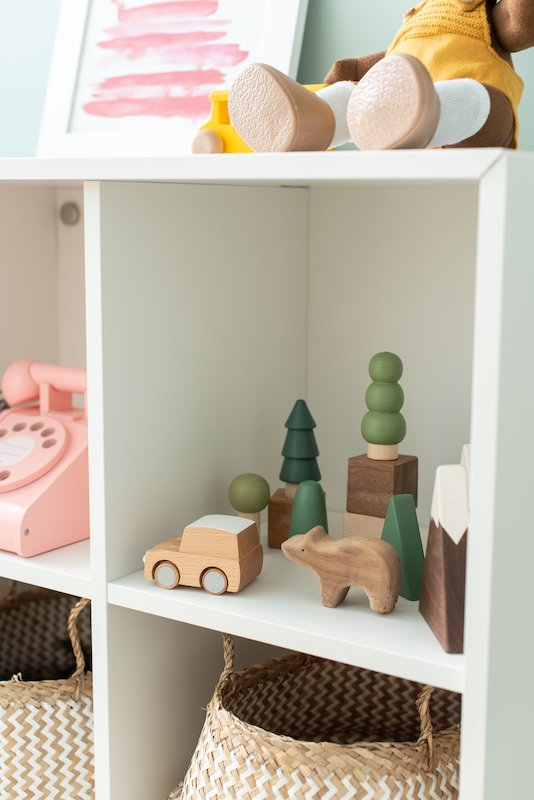grOH!'s Eight Educational Play Categories For Playroom Design
We've identified the 8 types of play every playroom should have for balanced play!
Reggio Emilia Schools refer to the play environment as the "third teacher," and we could not agree more. The contents of your child's play space matters! When designing a playroom, we design with, what we call, a balanced play approach. A balanced play environment is one that intentionally offers up opportunities for different types of play; one that encourages development of the whole child.
The contents of your child's play space matters!
At grOH!, we have identified 8 types of play that develop different areas of your child's brain. Different toys inspire different types of play, thereby causing different parts of the brain to work. This makes it important to stock the play space with a variety of toy types. Toys provide children with opportunities to reflect on and investigate their world, so intentionality stocking the playroom with high-quality toys from our 8 play categories encourages growth of the whole child and fosters balanced play and development.
Throughout this post, we'll share just a few of the many benefits of each play category. (We try to name some that may not immediately come to mind!) We want you to get acquainted with grOH!'s 8 Play Categories and learn more about why they should be a part of your home's play spaces!
1. Art Toys + Materials
(Introduce around 9 months)
Using a variety of materials to create art has a range of benefits outside of making a finished product—from building perseverance to encouraging scientific curiosity. Most of art's benefits result from the art-making process rather than the end product itself.
Examples
An art space includes many different materials. Depending on your child's age, they may or may not be accessible without you. An art space may include items such as:
Paint
Play-doh/ modeling clay
Oil Pastels
Dot Markers
Crayons
Recycled Materials
Digital Camera
Benefits you might not know about
Problem Solving Skills
Creating art rarely goes according to plan. It takes flexibility, planning, and problem solving in order to course- correct after a mistake. Art provides a safe environment to practice these skills, which will help children apply them more broadly later.
Visualizing Skills
Visual arts provides children with an opportunity to practice visualizing - the practice of imagining what something looks like or could look like! This skill will help them comprehend stories, do mental math, and decide between colors and materials to use when creating their artwork.
2. Building Toys
(Introduce around 6 months)
Building Toys foster our future architects, scientists, and engineers. The construction and demolition of building projects allows kiddos to creatively solve problems, experiment with cause and effect, and work with the mathematical concepts of size, symmetry, shape, and quantity.
Examples
Allow children to experience many different types and sizes of building materials.
Wooden Blocks
Mega Blocs/Duplos/LEGOS
Tegu Blocks
Magnetic Tiles
Lincoln Logs
Benefits you might not know about
Motor Skills
Building toys require children to move and manipulate small pieces, which develops the small muscles in their hands, wrists, and fingers (fine motor muscles). Every time they grab or pinch a block, they are doing a hand work out!
Self-Esteem
Successfully planning and building a structure according to that plan builds self-esteem and confidence, which helps kiddos bounce back from future setbacks during building play and beyond!
3. Gross Motor Toys
(Introduce at 9 months/crawling)
Gross motor toys build strong muscles and strong minds. The movements children do when they play with their whole bodies (legs, torso, and arms) help them to do amazing things from calming their nervous system so they can focus, to climbing into the car seat by themselves! There is also a significant amount of research that shows that a well-exercised body leads to more attentiveness and focus in school and beyond.
Examples
Tunnels
Trampolines
Balance Boards
Scooters
Large Blocks
Push/Pull Toys
Climbing Toys
Benefits you might not know about
Handwriting Skills
It may seem unrelated, but the core strength developed through gross motor play is directly related to a child's posture and ability to move their larger arm muscles when writing! Well-developed core muscles help children develop good handwriting habits!
Self-Awareness
Using gross motor toys helps children become more keenly aware of where their body is in space. They can then navigate the furniture in a room, walk up and down stairs, and more easily get on and off escalators and elevators. Not only do gross motor toys enable more dexterous movement, they also children improve the coordination between their eyes and large muscles.
4. Imagination + Dramatic Play Toys
Think pretend! Children create stories and act them out. You may be surprised that these skills begin blooming early through simple mimicking of everyday activities, like talking on the phone or stirring a pot. These simple acts of play are helping kiddos engage in the world they are experiencing and better understand it. In the mid to late toddler years, those simple acts will turn into complex play stories involving sophisticated characters like sweet house cats, invincible superheroes, or powerful princesses.
Examples
Play food/ cookware
Doctor Kit
Dress-up Clothes
Cash register
Briefcase
Benefits you might not know about
Cooperative Play Skills
Imaginative play is always more fun with friends, and children need a host of skills to navigate cooperative play. Children practice assigning characters, arranging the plot, and negotiating outcomes with their peers. The play becomes a large motivating force to do this difficult skill-building work with peers, like active listening, turn-taking and empathy.
Coping Skills
Have you seen your kiddo play school, pack up a bag to move, or pretend to be a doctor? This is play that is helping your kiddo understand, learn language around, and cope with new, confusing, or frightening life events. This provides caregivers a window into feelings children may not otherwise be able to verbalize or fully express.
5. Music Toys
(Introduce around 6 months)
Infusing a culture of music in your home is hugely beneficial for children and their overall development. Studies have shown that exposure to music early and often boosts mathematical understanding, math test scores, and even SAT scores.
Examples
Hand Drum
Tambourines
Harmonica
Egg Shaker
Xylophone
Recorder
You can also make musical instruments out of household items like plastic storage containers.
Benefits you might not know about
Self-Soothing Skills
Music brings joy to both adults and children. Listening to music has the power to change our moods and offers an opportunity to recharge. Kiddos can learn to use music as a calming down strategy when they are feeling upset, angry, or anxious. Integrate music into calm moments and play it and/or offer to play it when kiddos are feeling agitated.
Math Skills
Math is the study of patterns. The rhythm, beats, and repetition in songs helps children learn about and experience patterns. Children can count the beats (1,2,3,4 & repeat), listen to the verse repeat, and listen to the words repeat and rhyme. Songs are musical examples of patterns. As kiddos understand more complex patterns, they can begin to create their own.
6. Puzzles + Games + LEGO Kits
(Introduce around 6 months)
Puzzles have a broad range of benefits from building mathematical skills to practicing perseverance. Puzzles follow a clear progression. Once your child shows mastery of one puzzle type, introduce the next!
Examples
Puzzle Toy Types In Order Of Complexity
Large peg puzzles, chunky puzzles, small peg puzzles, and jig-saw
puzzles (increasing in complexity based on the number of pieces and picture intricacy)
Benefits you might not know about
Mathematical Skills
Math is more than counting and recognizing numbers. It is a complex combination of skills including pattern, size and shape recognition, spatial awareness, and problem solving, all of which puzzle play fosters! As children first try and then repeatedly work on puzzles, they must apply their past knowledge and logical thinking in order to solve them. They hone skills that they will later, in school, call geometry, including developing an understanding around shape, size, position, direction, and movement. Hello, future mathematicians!
Self-Control Skills (nerdy educational term: Executive Functioning)
Puzzles require patience and planning. Children must have a plan, try it out, and pivot in order to successfully solve a puzzle. This requires focus, memory development, and coping skills when a puzzle is challenging.
**fun fact:
Puzzles, Board Games & Lego kits are one of the few toy categories at we install in every play space that are NOT open ended toys.
7. Skill-Development Toys
(Introduce around 3 months)
Many of the toys that fall into the skill-development category specifically work to develop fine-motor skills, muscle strengthening of the muscles in the fingers, hand, and wrist. Young children are constantly learning new skills and ways to use their hands and fingers.
Examples
Skill building toys often have a singular purpose and typically promote fine motor skills, which is why we recommend the most open ended versions of these toys and materials. You can also use household items as toys for this practice, just remember to monitor your child carefully during play.
Cups (for stacking)
Beads or Boards (for lacing)
Lids (for twisting)
Funnels, Containers (for pouring)
ABC Toys (for letter learning)
Benefits you might not know about
Concentration Skills
Kiddos often obsess when they are learning a new skill. They want to practice it constantly. The more we let them practice, the more we allow them to build the stamina required to focus on a single task for a long period of time.
Hand-Eye Coordination
So many skills require hand eye coordination — from handwriting to buckling to catching a ball. The more children practice, the better pathways their brains develop between their brain (that interprets what the eye sees) and their body (how their hands respond).
8. Small World Toys
(Introduce around 12-18 months)
Small World is a term that describes any toy that can be used to create a miniature version of the world. Creating stories around their toys primes kids' brains for storytelling, reading, and, later, creative writing!
Examples
Doll + Dollhouse
Farm Animals + Barn
Trains + Tracks
Cars + Roads
Dinosaurs + Trees
Benefits you might not know about
Math Skills
Small world toys give children an authentic reason to understand quantity, sorting, measurement, and numeracy. Children may pair one doll with one bed in the doll house, separate all the dogs from the cats in the animal shelter, or build a bigger corral to contain all of their farm animals.
Motor Skills
Playing with small world toys requires children to use the muscles in their wrists, hands and fingers to move their toys to create movement and action.
Not sure what you need?
Don't worry, we're here for you!
We'll help you design and organize the perfectly balanced playroom to turn your house into a learning environment that sparks creativity, problem solving, and independence!
Click here to schedule a call about your project!

















